Comparative Study of Deliberate and Emergent Strategies
VerifiedAdded on 2023/06/03
|10
|2683
|290
AI Summary
This essay provides a comparative study of deliberate and emergent strategies, their differences, and real-life examples. It also discusses the implementation of these strategies on personal traits.
Contribute Materials
Your contribution can guide someone’s learning journey. Share your
documents today.
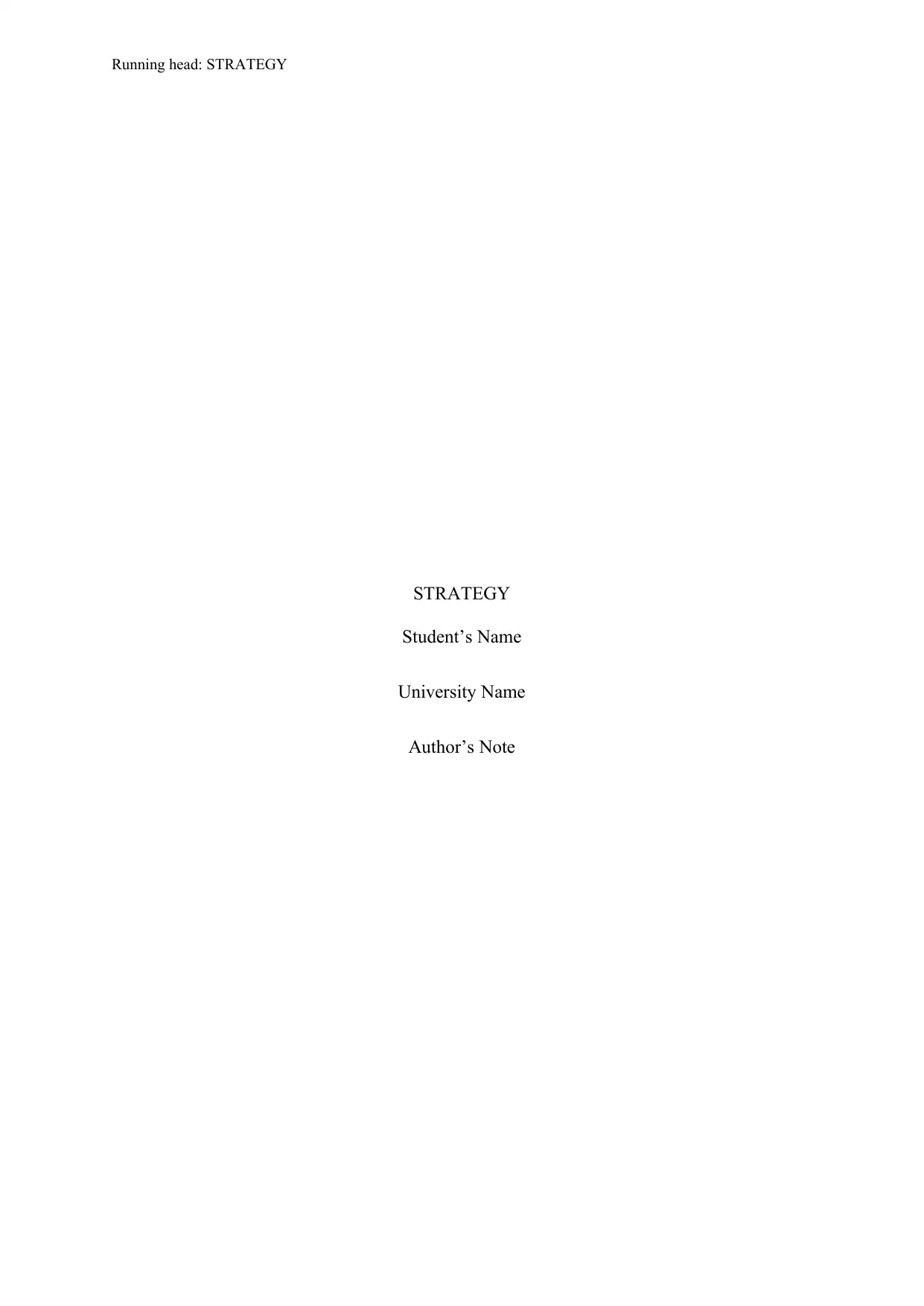
Running head: STRATEGY
STRATEGY
Student’s Name
University Name
Author’s Note
STRATEGY
Student’s Name
University Name
Author’s Note
Secure Best Marks with AI Grader
Need help grading? Try our AI Grader for instant feedback on your assignments.
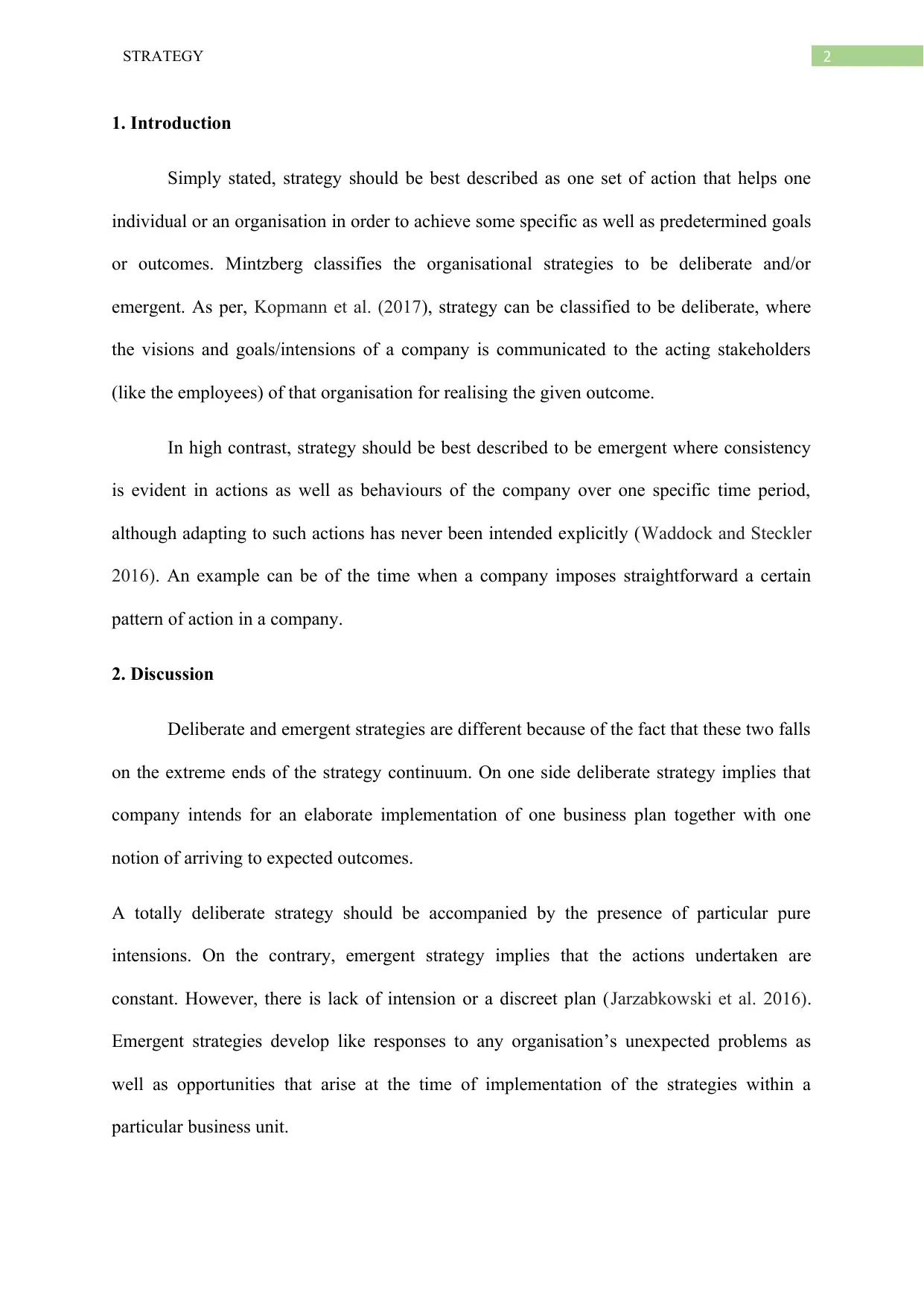
2STRATEGY
1. Introduction
Simply stated, strategy should be best described as one set of action that helps one
individual or an organisation in order to achieve some specific as well as predetermined goals
or outcomes. Mintzberg classifies the organisational strategies to be deliberate and/or
emergent. As per, Kopmann et al. (2017), strategy can be classified to be deliberate, where
the visions and goals/intensions of a company is communicated to the acting stakeholders
(like the employees) of that organisation for realising the given outcome.
In high contrast, strategy should be best described to be emergent where consistency
is evident in actions as well as behaviours of the company over one specific time period,
although adapting to such actions has never been intended explicitly (Waddock and Steckler
2016). An example can be of the time when a company imposes straightforward a certain
pattern of action in a company.
2. Discussion
Deliberate and emergent strategies are different because of the fact that these two falls
on the extreme ends of the strategy continuum. On one side deliberate strategy implies that
company intends for an elaborate implementation of one business plan together with one
notion of arriving to expected outcomes.
A totally deliberate strategy should be accompanied by the presence of particular pure
intensions. On the contrary, emergent strategy implies that the actions undertaken are
constant. However, there is lack of intension or a discreet plan (Jarzabkowski et al. 2016).
Emergent strategies develop like responses to any organisation’s unexpected problems as
well as opportunities that arise at the time of implementation of the strategies within a
particular business unit.
1. Introduction
Simply stated, strategy should be best described as one set of action that helps one
individual or an organisation in order to achieve some specific as well as predetermined goals
or outcomes. Mintzberg classifies the organisational strategies to be deliberate and/or
emergent. As per, Kopmann et al. (2017), strategy can be classified to be deliberate, where
the visions and goals/intensions of a company is communicated to the acting stakeholders
(like the employees) of that organisation for realising the given outcome.
In high contrast, strategy should be best described to be emergent where consistency
is evident in actions as well as behaviours of the company over one specific time period,
although adapting to such actions has never been intended explicitly (Waddock and Steckler
2016). An example can be of the time when a company imposes straightforward a certain
pattern of action in a company.
2. Discussion
Deliberate and emergent strategies are different because of the fact that these two falls
on the extreme ends of the strategy continuum. On one side deliberate strategy implies that
company intends for an elaborate implementation of one business plan together with one
notion of arriving to expected outcomes.
A totally deliberate strategy should be accompanied by the presence of particular pure
intensions. On the contrary, emergent strategy implies that the actions undertaken are
constant. However, there is lack of intension or a discreet plan (Jarzabkowski et al. 2016).
Emergent strategies develop like responses to any organisation’s unexpected problems as
well as opportunities that arise at the time of implementation of the strategies within a
particular business unit.
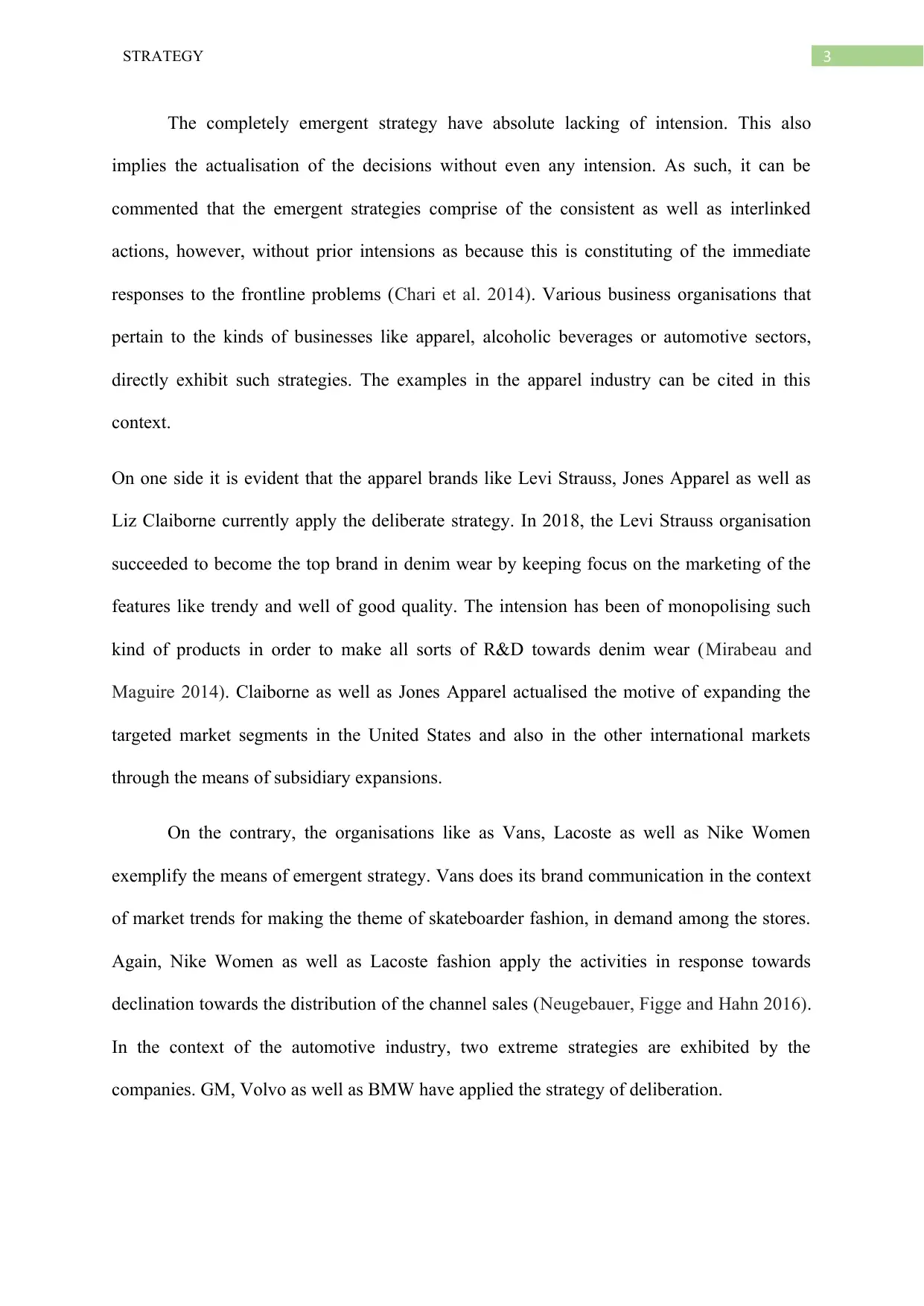
3STRATEGY
The completely emergent strategy have absolute lacking of intension. This also
implies the actualisation of the decisions without even any intension. As such, it can be
commented that the emergent strategies comprise of the consistent as well as interlinked
actions, however, without prior intensions as because this is constituting of the immediate
responses to the frontline problems (Chari et al. 2014). Various business organisations that
pertain to the kinds of businesses like apparel, alcoholic beverages or automotive sectors,
directly exhibit such strategies. The examples in the apparel industry can be cited in this
context.
On one side it is evident that the apparel brands like Levi Strauss, Jones Apparel as well as
Liz Claiborne currently apply the deliberate strategy. In 2018, the Levi Strauss organisation
succeeded to become the top brand in denim wear by keeping focus on the marketing of the
features like trendy and well of good quality. The intension has been of monopolising such
kind of products in order to make all sorts of R&D towards denim wear (Mirabeau and
Maguire 2014). Claiborne as well as Jones Apparel actualised the motive of expanding the
targeted market segments in the United States and also in the other international markets
through the means of subsidiary expansions.
On the contrary, the organisations like as Vans, Lacoste as well as Nike Women
exemplify the means of emergent strategy. Vans does its brand communication in the context
of market trends for making the theme of skateboarder fashion, in demand among the stores.
Again, Nike Women as well as Lacoste fashion apply the activities in response towards
declination towards the distribution of the channel sales (Neugebauer, Figge and Hahn 2016).
In the context of the automotive industry, two extreme strategies are exhibited by the
companies. GM, Volvo as well as BMW have applied the strategy of deliberation.
The completely emergent strategy have absolute lacking of intension. This also
implies the actualisation of the decisions without even any intension. As such, it can be
commented that the emergent strategies comprise of the consistent as well as interlinked
actions, however, without prior intensions as because this is constituting of the immediate
responses to the frontline problems (Chari et al. 2014). Various business organisations that
pertain to the kinds of businesses like apparel, alcoholic beverages or automotive sectors,
directly exhibit such strategies. The examples in the apparel industry can be cited in this
context.
On one side it is evident that the apparel brands like Levi Strauss, Jones Apparel as well as
Liz Claiborne currently apply the deliberate strategy. In 2018, the Levi Strauss organisation
succeeded to become the top brand in denim wear by keeping focus on the marketing of the
features like trendy and well of good quality. The intension has been of monopolising such
kind of products in order to make all sorts of R&D towards denim wear (Mirabeau and
Maguire 2014). Claiborne as well as Jones Apparel actualised the motive of expanding the
targeted market segments in the United States and also in the other international markets
through the means of subsidiary expansions.
On the contrary, the organisations like as Vans, Lacoste as well as Nike Women
exemplify the means of emergent strategy. Vans does its brand communication in the context
of market trends for making the theme of skateboarder fashion, in demand among the stores.
Again, Nike Women as well as Lacoste fashion apply the activities in response towards
declination towards the distribution of the channel sales (Neugebauer, Figge and Hahn 2016).
In the context of the automotive industry, two extreme strategies are exhibited by the
companies. GM, Volvo as well as BMW have applied the strategy of deliberation.
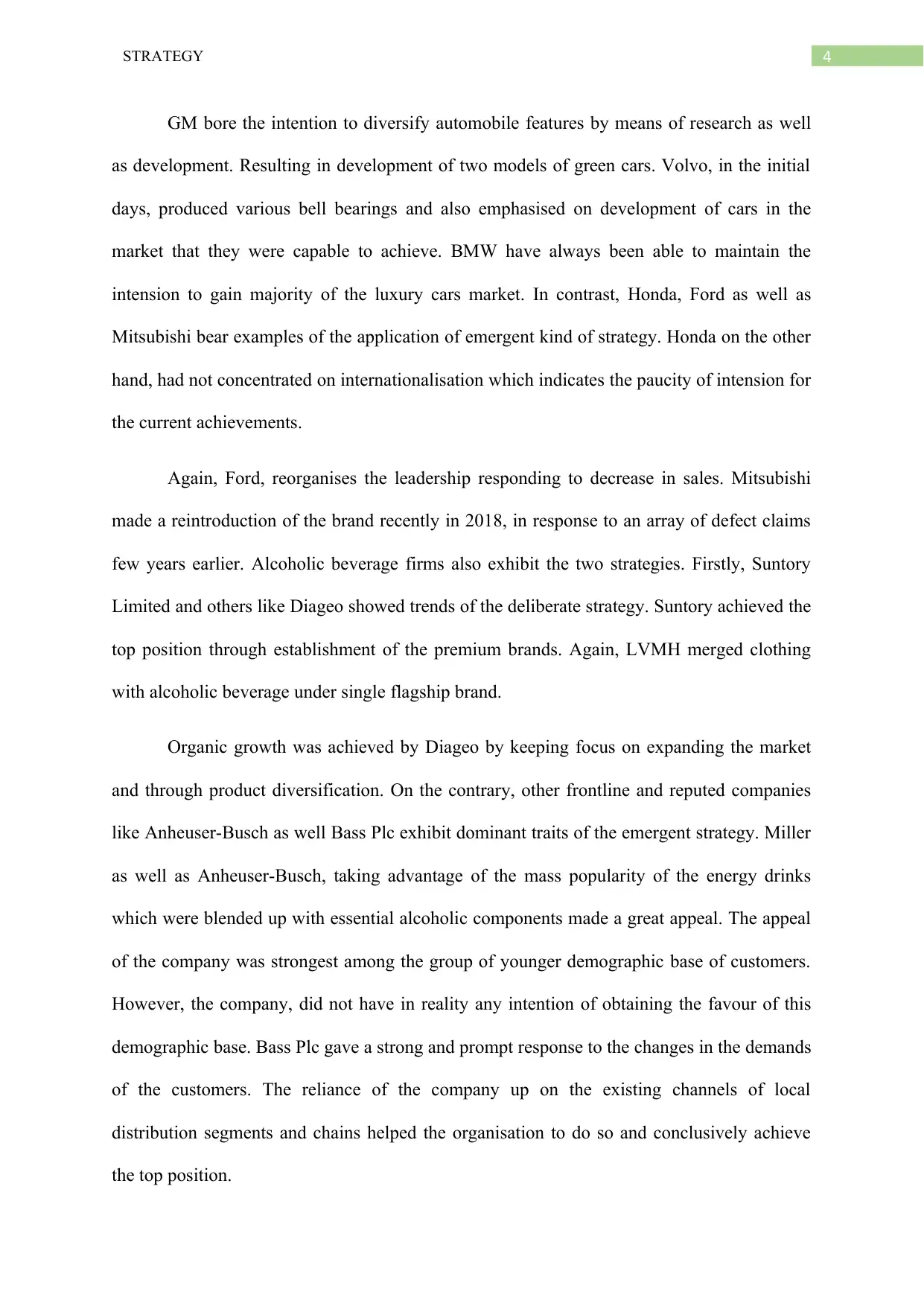
4STRATEGY
GM bore the intention to diversify automobile features by means of research as well
as development. Resulting in development of two models of green cars. Volvo, in the initial
days, produced various bell bearings and also emphasised on development of cars in the
market that they were capable to achieve. BMW have always been able to maintain the
intension to gain majority of the luxury cars market. In contrast, Honda, Ford as well as
Mitsubishi bear examples of the application of emergent kind of strategy. Honda on the other
hand, had not concentrated on internationalisation which indicates the paucity of intension for
the current achievements.
Again, Ford, reorganises the leadership responding to decrease in sales. Mitsubishi
made a reintroduction of the brand recently in 2018, in response to an array of defect claims
few years earlier. Alcoholic beverage firms also exhibit the two strategies. Firstly, Suntory
Limited and others like Diageo showed trends of the deliberate strategy. Suntory achieved the
top position through establishment of the premium brands. Again, LVMH merged clothing
with alcoholic beverage under single flagship brand.
Organic growth was achieved by Diageo by keeping focus on expanding the market
and through product diversification. On the contrary, other frontline and reputed companies
like Anheuser-Busch as well Bass Plc exhibit dominant traits of the emergent strategy. Miller
as well as Anheuser-Busch, taking advantage of the mass popularity of the energy drinks
which were blended up with essential alcoholic components made a great appeal. The appeal
of the company was strongest among the group of younger demographic base of customers.
However, the company, did not have in reality any intention of obtaining the favour of this
demographic base. Bass Plc gave a strong and prompt response to the changes in the demands
of the customers. The reliance of the company up on the existing channels of local
distribution segments and chains helped the organisation to do so and conclusively achieve
the top position.
GM bore the intention to diversify automobile features by means of research as well
as development. Resulting in development of two models of green cars. Volvo, in the initial
days, produced various bell bearings and also emphasised on development of cars in the
market that they were capable to achieve. BMW have always been able to maintain the
intension to gain majority of the luxury cars market. In contrast, Honda, Ford as well as
Mitsubishi bear examples of the application of emergent kind of strategy. Honda on the other
hand, had not concentrated on internationalisation which indicates the paucity of intension for
the current achievements.
Again, Ford, reorganises the leadership responding to decrease in sales. Mitsubishi
made a reintroduction of the brand recently in 2018, in response to an array of defect claims
few years earlier. Alcoholic beverage firms also exhibit the two strategies. Firstly, Suntory
Limited and others like Diageo showed trends of the deliberate strategy. Suntory achieved the
top position through establishment of the premium brands. Again, LVMH merged clothing
with alcoholic beverage under single flagship brand.
Organic growth was achieved by Diageo by keeping focus on expanding the market
and through product diversification. On the contrary, other frontline and reputed companies
like Anheuser-Busch as well Bass Plc exhibit dominant traits of the emergent strategy. Miller
as well as Anheuser-Busch, taking advantage of the mass popularity of the energy drinks
which were blended up with essential alcoholic components made a great appeal. The appeal
of the company was strongest among the group of younger demographic base of customers.
However, the company, did not have in reality any intention of obtaining the favour of this
demographic base. Bass Plc gave a strong and prompt response to the changes in the demands
of the customers. The reliance of the company up on the existing channels of local
distribution segments and chains helped the organisation to do so and conclusively achieve
the top position.
Secure Best Marks with AI Grader
Need help grading? Try our AI Grader for instant feedback on your assignments.
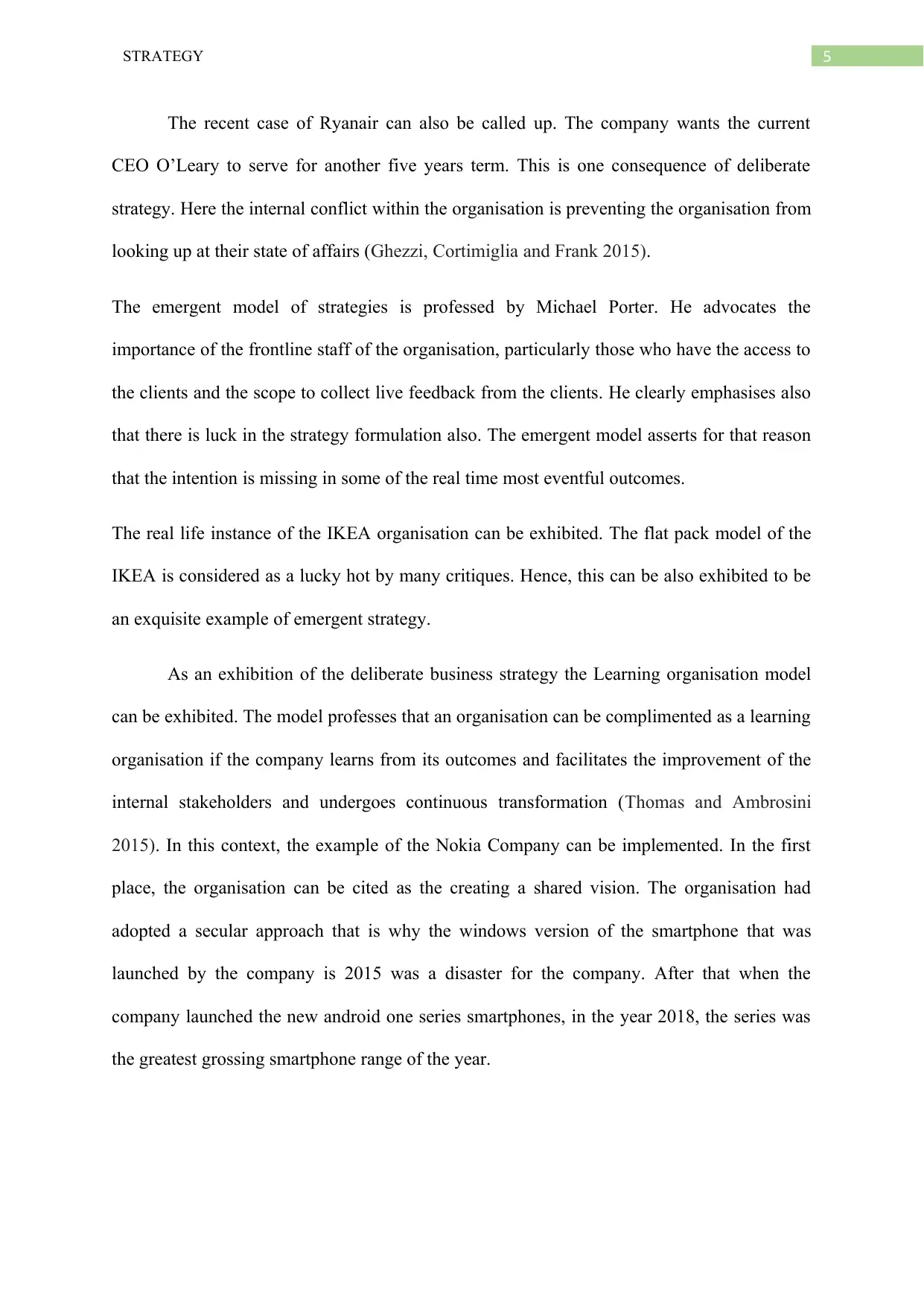
5STRATEGY
The recent case of Ryanair can also be called up. The company wants the current
CEO O’Leary to serve for another five years term. This is one consequence of deliberate
strategy. Here the internal conflict within the organisation is preventing the organisation from
looking up at their state of affairs (Ghezzi, Cortimiglia and Frank 2015).
The emergent model of strategies is professed by Michael Porter. He advocates the
importance of the frontline staff of the organisation, particularly those who have the access to
the clients and the scope to collect live feedback from the clients. He clearly emphasises also
that there is luck in the strategy formulation also. The emergent model asserts for that reason
that the intention is missing in some of the real time most eventful outcomes.
The real life instance of the IKEA organisation can be exhibited. The flat pack model of the
IKEA is considered as a lucky hot by many critiques. Hence, this can be also exhibited to be
an exquisite example of emergent strategy.
As an exhibition of the deliberate business strategy the Learning organisation model
can be exhibited. The model professes that an organisation can be complimented as a learning
organisation if the company learns from its outcomes and facilitates the improvement of the
internal stakeholders and undergoes continuous transformation (Thomas and Ambrosini
2015). In this context, the example of the Nokia Company can be implemented. In the first
place, the organisation can be cited as the creating a shared vision. The organisation had
adopted a secular approach that is why the windows version of the smartphone that was
launched by the company is 2015 was a disaster for the company. After that when the
company launched the new android one series smartphones, in the year 2018, the series was
the greatest grossing smartphone range of the year.
The recent case of Ryanair can also be called up. The company wants the current
CEO O’Leary to serve for another five years term. This is one consequence of deliberate
strategy. Here the internal conflict within the organisation is preventing the organisation from
looking up at their state of affairs (Ghezzi, Cortimiglia and Frank 2015).
The emergent model of strategies is professed by Michael Porter. He advocates the
importance of the frontline staff of the organisation, particularly those who have the access to
the clients and the scope to collect live feedback from the clients. He clearly emphasises also
that there is luck in the strategy formulation also. The emergent model asserts for that reason
that the intention is missing in some of the real time most eventful outcomes.
The real life instance of the IKEA organisation can be exhibited. The flat pack model of the
IKEA is considered as a lucky hot by many critiques. Hence, this can be also exhibited to be
an exquisite example of emergent strategy.
As an exhibition of the deliberate business strategy the Learning organisation model
can be exhibited. The model professes that an organisation can be complimented as a learning
organisation if the company learns from its outcomes and facilitates the improvement of the
internal stakeholders and undergoes continuous transformation (Thomas and Ambrosini
2015). In this context, the example of the Nokia Company can be implemented. In the first
place, the organisation can be cited as the creating a shared vision. The organisation had
adopted a secular approach that is why the windows version of the smartphone that was
launched by the company is 2015 was a disaster for the company. After that when the
company launched the new android one series smartphones, in the year 2018, the series was
the greatest grossing smartphone range of the year.
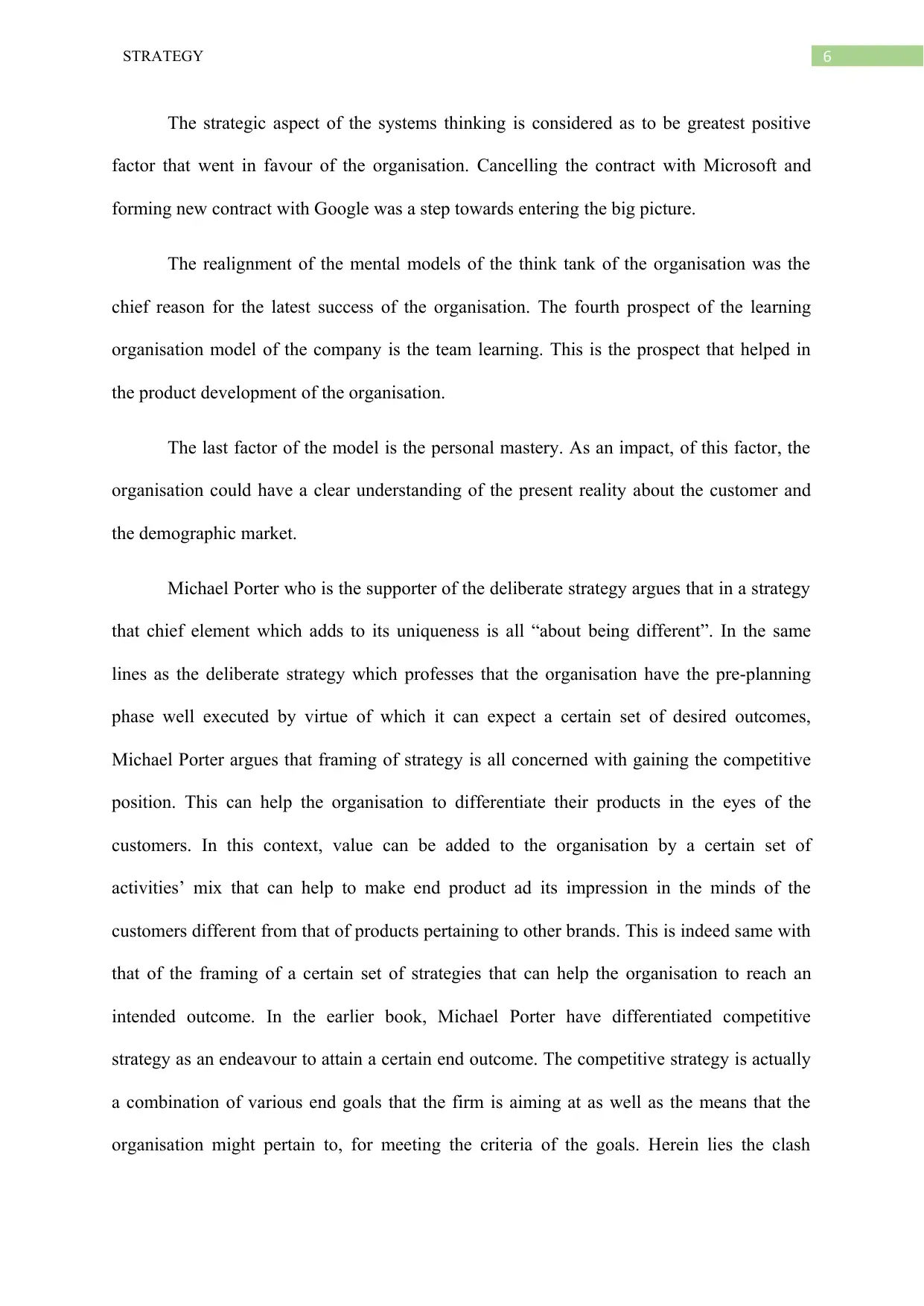
6STRATEGY
The strategic aspect of the systems thinking is considered as to be greatest positive
factor that went in favour of the organisation. Cancelling the contract with Microsoft and
forming new contract with Google was a step towards entering the big picture.
The realignment of the mental models of the think tank of the organisation was the
chief reason for the latest success of the organisation. The fourth prospect of the learning
organisation model of the company is the team learning. This is the prospect that helped in
the product development of the organisation.
The last factor of the model is the personal mastery. As an impact, of this factor, the
organisation could have a clear understanding of the present reality about the customer and
the demographic market.
Michael Porter who is the supporter of the deliberate strategy argues that in a strategy
that chief element which adds to its uniqueness is all “about being different”. In the same
lines as the deliberate strategy which professes that the organisation have the pre-planning
phase well executed by virtue of which it can expect a certain set of desired outcomes,
Michael Porter argues that framing of strategy is all concerned with gaining the competitive
position. This can help the organisation to differentiate their products in the eyes of the
customers. In this context, value can be added to the organisation by a certain set of
activities’ mix that can help to make end product ad its impression in the minds of the
customers different from that of products pertaining to other brands. This is indeed same with
that of the framing of a certain set of strategies that can help the organisation to reach an
intended outcome. In the earlier book, Michael Porter have differentiated competitive
strategy as an endeavour to attain a certain end outcome. The competitive strategy is actually
a combination of various end goals that the firm is aiming at as well as the means that the
organisation might pertain to, for meeting the criteria of the goals. Herein lies the clash
The strategic aspect of the systems thinking is considered as to be greatest positive
factor that went in favour of the organisation. Cancelling the contract with Microsoft and
forming new contract with Google was a step towards entering the big picture.
The realignment of the mental models of the think tank of the organisation was the
chief reason for the latest success of the organisation. The fourth prospect of the learning
organisation model of the company is the team learning. This is the prospect that helped in
the product development of the organisation.
The last factor of the model is the personal mastery. As an impact, of this factor, the
organisation could have a clear understanding of the present reality about the customer and
the demographic market.
Michael Porter who is the supporter of the deliberate strategy argues that in a strategy
that chief element which adds to its uniqueness is all “about being different”. In the same
lines as the deliberate strategy which professes that the organisation have the pre-planning
phase well executed by virtue of which it can expect a certain set of desired outcomes,
Michael Porter argues that framing of strategy is all concerned with gaining the competitive
position. This can help the organisation to differentiate their products in the eyes of the
customers. In this context, value can be added to the organisation by a certain set of
activities’ mix that can help to make end product ad its impression in the minds of the
customers different from that of products pertaining to other brands. This is indeed same with
that of the framing of a certain set of strategies that can help the organisation to reach an
intended outcome. In the earlier book, Michael Porter have differentiated competitive
strategy as an endeavour to attain a certain end outcome. The competitive strategy is actually
a combination of various end goals that the firm is aiming at as well as the means that the
organisation might pertain to, for meeting the criteria of the goals. Herein lies the clash
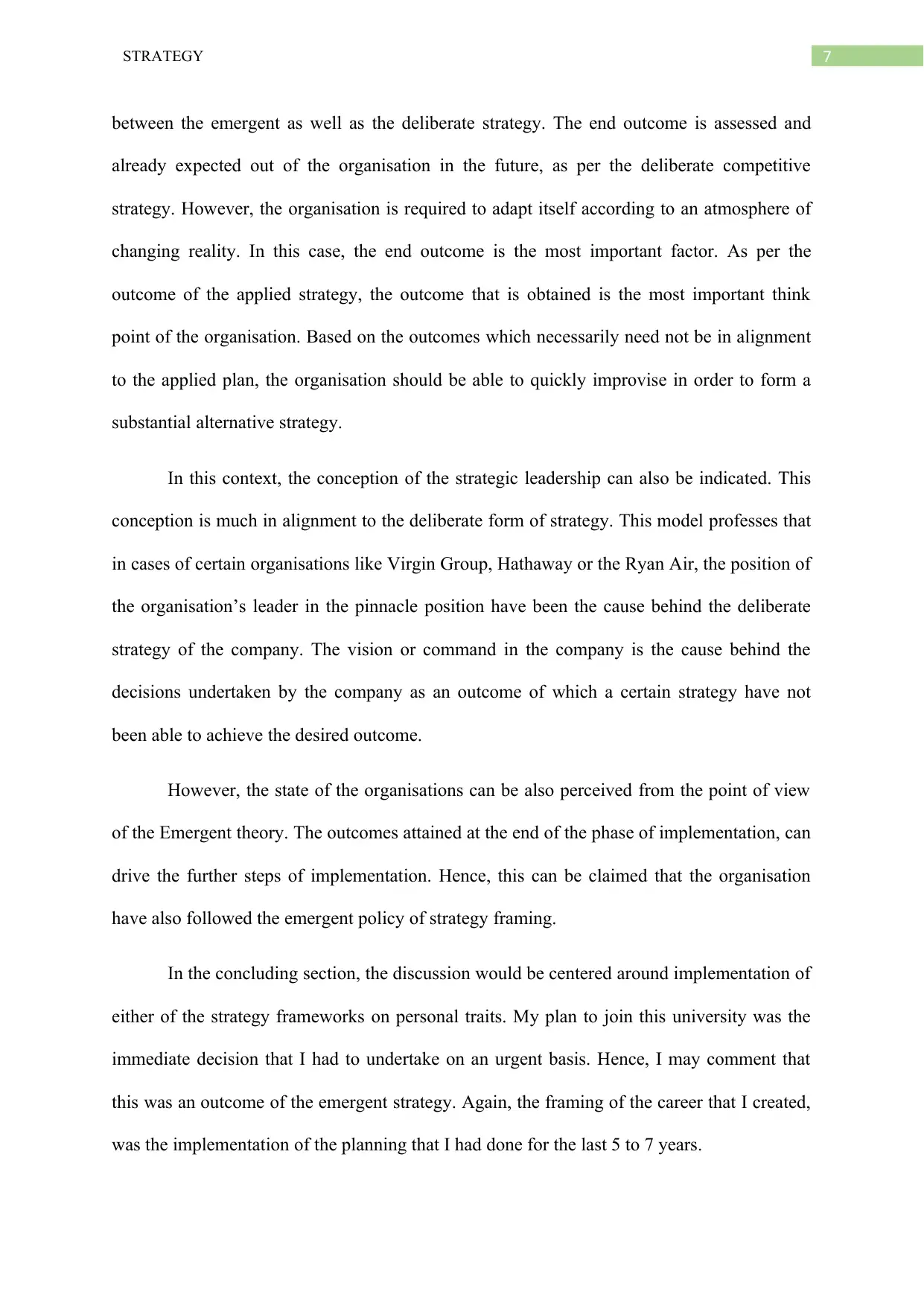
7STRATEGY
between the emergent as well as the deliberate strategy. The end outcome is assessed and
already expected out of the organisation in the future, as per the deliberate competitive
strategy. However, the organisation is required to adapt itself according to an atmosphere of
changing reality. In this case, the end outcome is the most important factor. As per the
outcome of the applied strategy, the outcome that is obtained is the most important think
point of the organisation. Based on the outcomes which necessarily need not be in alignment
to the applied plan, the organisation should be able to quickly improvise in order to form a
substantial alternative strategy.
In this context, the conception of the strategic leadership can also be indicated. This
conception is much in alignment to the deliberate form of strategy. This model professes that
in cases of certain organisations like Virgin Group, Hathaway or the Ryan Air, the position of
the organisation’s leader in the pinnacle position have been the cause behind the deliberate
strategy of the company. The vision or command in the company is the cause behind the
decisions undertaken by the company as an outcome of which a certain strategy have not
been able to achieve the desired outcome.
However, the state of the organisations can be also perceived from the point of view
of the Emergent theory. The outcomes attained at the end of the phase of implementation, can
drive the further steps of implementation. Hence, this can be claimed that the organisation
have also followed the emergent policy of strategy framing.
In the concluding section, the discussion would be centered around implementation of
either of the strategy frameworks on personal traits. My plan to join this university was the
immediate decision that I had to undertake on an urgent basis. Hence, I may comment that
this was an outcome of the emergent strategy. Again, the framing of the career that I created,
was the implementation of the planning that I had done for the last 5 to 7 years.
between the emergent as well as the deliberate strategy. The end outcome is assessed and
already expected out of the organisation in the future, as per the deliberate competitive
strategy. However, the organisation is required to adapt itself according to an atmosphere of
changing reality. In this case, the end outcome is the most important factor. As per the
outcome of the applied strategy, the outcome that is obtained is the most important think
point of the organisation. Based on the outcomes which necessarily need not be in alignment
to the applied plan, the organisation should be able to quickly improvise in order to form a
substantial alternative strategy.
In this context, the conception of the strategic leadership can also be indicated. This
conception is much in alignment to the deliberate form of strategy. This model professes that
in cases of certain organisations like Virgin Group, Hathaway or the Ryan Air, the position of
the organisation’s leader in the pinnacle position have been the cause behind the deliberate
strategy of the company. The vision or command in the company is the cause behind the
decisions undertaken by the company as an outcome of which a certain strategy have not
been able to achieve the desired outcome.
However, the state of the organisations can be also perceived from the point of view
of the Emergent theory. The outcomes attained at the end of the phase of implementation, can
drive the further steps of implementation. Hence, this can be claimed that the organisation
have also followed the emergent policy of strategy framing.
In the concluding section, the discussion would be centered around implementation of
either of the strategy frameworks on personal traits. My plan to join this university was the
immediate decision that I had to undertake on an urgent basis. Hence, I may comment that
this was an outcome of the emergent strategy. Again, the framing of the career that I created,
was the implementation of the planning that I had done for the last 5 to 7 years.
Paraphrase This Document
Need a fresh take? Get an instant paraphrase of this document with our AI Paraphraser
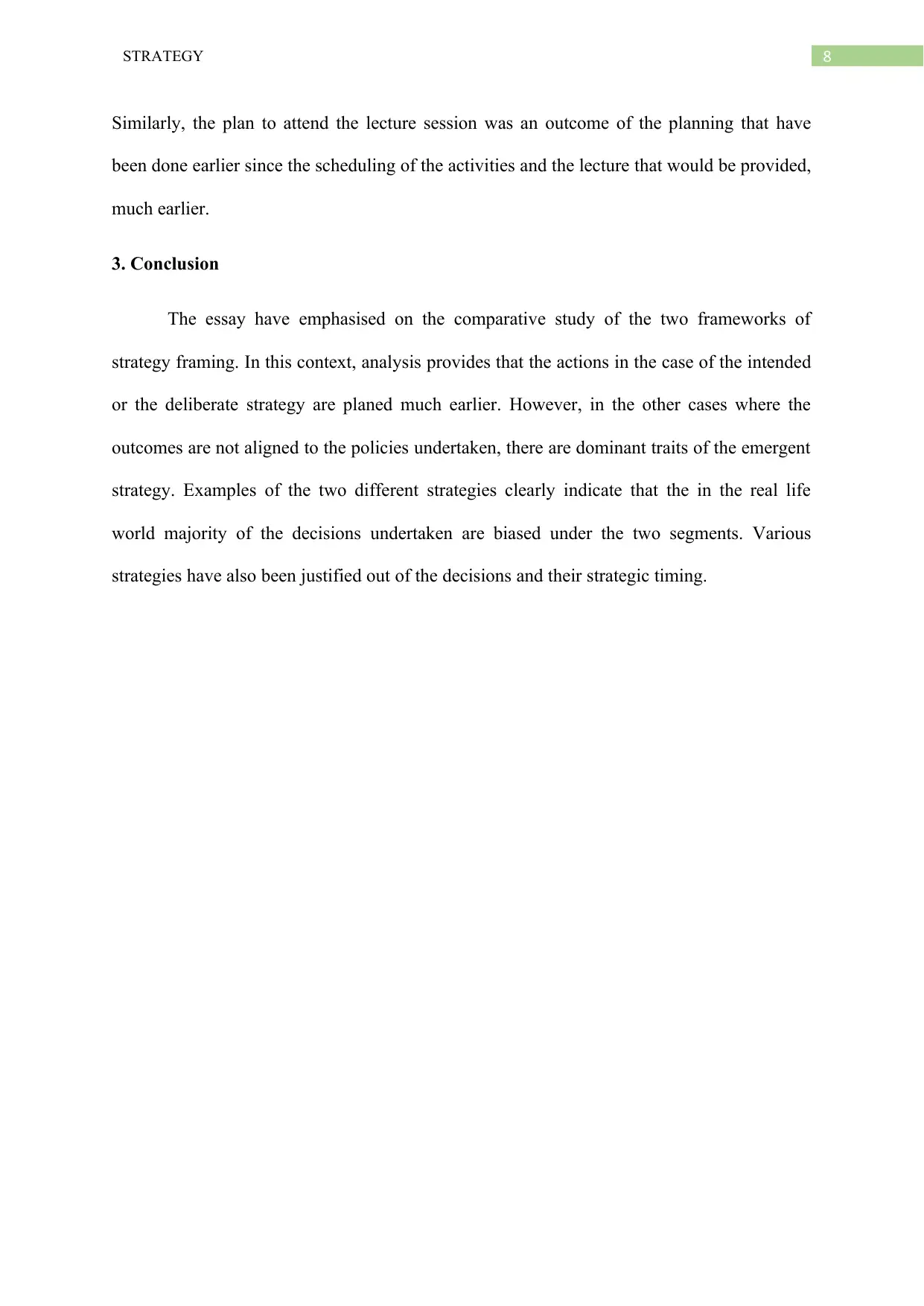
8STRATEGY
Similarly, the plan to attend the lecture session was an outcome of the planning that have
been done earlier since the scheduling of the activities and the lecture that would be provided,
much earlier.
3. Conclusion
The essay have emphasised on the comparative study of the two frameworks of
strategy framing. In this context, analysis provides that the actions in the case of the intended
or the deliberate strategy are planed much earlier. However, in the other cases where the
outcomes are not aligned to the policies undertaken, there are dominant traits of the emergent
strategy. Examples of the two different strategies clearly indicate that the in the real life
world majority of the decisions undertaken are biased under the two segments. Various
strategies have also been justified out of the decisions and their strategic timing.
Similarly, the plan to attend the lecture session was an outcome of the planning that have
been done earlier since the scheduling of the activities and the lecture that would be provided,
much earlier.
3. Conclusion
The essay have emphasised on the comparative study of the two frameworks of
strategy framing. In this context, analysis provides that the actions in the case of the intended
or the deliberate strategy are planed much earlier. However, in the other cases where the
outcomes are not aligned to the policies undertaken, there are dominant traits of the emergent
strategy. Examples of the two different strategies clearly indicate that the in the real life
world majority of the decisions undertaken are biased under the two segments. Various
strategies have also been justified out of the decisions and their strategic timing.

9STRATEGY
Reference List
Charest, F., Bouffard, J. and Zajmovic, E., 2016. Public relations and social media:
Deliberate or creative strategic planning. Public Relations Review, 42(4), pp.530-538.
Charest, F., Bouffard, J. and Zajmovic, E., 2016. Public relations and social media:
Deliberate or creative strategic planning. Public Relations Review, 42(4), pp.530-538.
Chari, S., Katsikeas, C.S., Balabanis, G. and Robson, M.J., 2014. Emergent marketing
strategies and performance: The effects of market uncertainty and strategic feedback
systems. British Journal of Management, 25(2), pp.145-165.
Egels-Zandén, N. and Rosén, M., 2015. Sustainable strategy formation at a Swedish
industrial company: bridging the strategy-as-practice and sustainability gap. Journal of
Cleaner Production, 96, pp.139-147.
Ghezzi, A., Cortimiglia, M.N. and Frank, A.G., 2015. Strategy and business model design in
dynamic telecommunications industries: A study on Italian mobile network
operators. Technological Forecasting and Social Change, 90, pp.346-354.
Jarzabkowski, P., Kaplan, S., Seidl, D. and Whittington, R., 2016. On the risk of studying
practices in isolation: Linking what, who, and how in strategy research. Strategic
Organization, 14(3), pp.248-259.
Kopmann, J., Kock, A., Killen, C.P. and Gemünden, H.G., 2017. The role of project portfolio
management in fostering both deliberate and emergent strategy. International Journal of
Project Management, 35(4), pp.557-570.
Mirabeau, L. and Maguire, S., 2014. From autonomous strategic behavior to emergent
strategy. Strategic Management Journal, 35(8), pp.1202-1229.
Reference List
Charest, F., Bouffard, J. and Zajmovic, E., 2016. Public relations and social media:
Deliberate or creative strategic planning. Public Relations Review, 42(4), pp.530-538.
Charest, F., Bouffard, J. and Zajmovic, E., 2016. Public relations and social media:
Deliberate or creative strategic planning. Public Relations Review, 42(4), pp.530-538.
Chari, S., Katsikeas, C.S., Balabanis, G. and Robson, M.J., 2014. Emergent marketing
strategies and performance: The effects of market uncertainty and strategic feedback
systems. British Journal of Management, 25(2), pp.145-165.
Egels-Zandén, N. and Rosén, M., 2015. Sustainable strategy formation at a Swedish
industrial company: bridging the strategy-as-practice and sustainability gap. Journal of
Cleaner Production, 96, pp.139-147.
Ghezzi, A., Cortimiglia, M.N. and Frank, A.G., 2015. Strategy and business model design in
dynamic telecommunications industries: A study on Italian mobile network
operators. Technological Forecasting and Social Change, 90, pp.346-354.
Jarzabkowski, P., Kaplan, S., Seidl, D. and Whittington, R., 2016. On the risk of studying
practices in isolation: Linking what, who, and how in strategy research. Strategic
Organization, 14(3), pp.248-259.
Kopmann, J., Kock, A., Killen, C.P. and Gemünden, H.G., 2017. The role of project portfolio
management in fostering both deliberate and emergent strategy. International Journal of
Project Management, 35(4), pp.557-570.
Mirabeau, L. and Maguire, S., 2014. From autonomous strategic behavior to emergent
strategy. Strategic Management Journal, 35(8), pp.1202-1229.
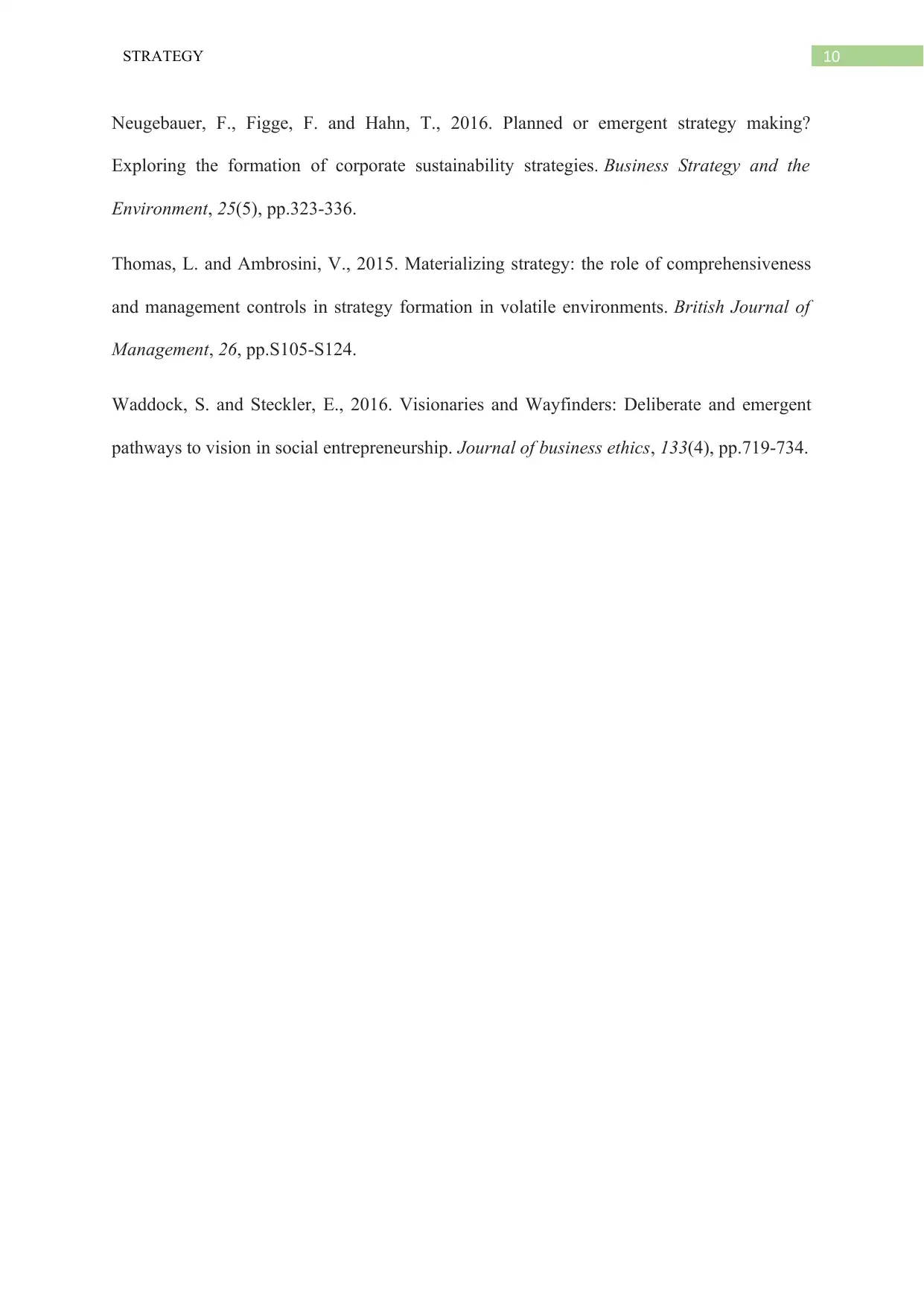
10STRATEGY
Neugebauer, F., Figge, F. and Hahn, T., 2016. Planned or emergent strategy making?
Exploring the formation of corporate sustainability strategies. Business Strategy and the
Environment, 25(5), pp.323-336.
Thomas, L. and Ambrosini, V., 2015. Materializing strategy: the role of comprehensiveness
and management controls in strategy formation in volatile environments. British Journal of
Management, 26, pp.S105-S124.
Waddock, S. and Steckler, E., 2016. Visionaries and Wayfinders: Deliberate and emergent
pathways to vision in social entrepreneurship. Journal of business ethics, 133(4), pp.719-734.
Neugebauer, F., Figge, F. and Hahn, T., 2016. Planned or emergent strategy making?
Exploring the formation of corporate sustainability strategies. Business Strategy and the
Environment, 25(5), pp.323-336.
Thomas, L. and Ambrosini, V., 2015. Materializing strategy: the role of comprehensiveness
and management controls in strategy formation in volatile environments. British Journal of
Management, 26, pp.S105-S124.
Waddock, S. and Steckler, E., 2016. Visionaries and Wayfinders: Deliberate and emergent
pathways to vision in social entrepreneurship. Journal of business ethics, 133(4), pp.719-734.
1 out of 10
Related Documents
Your All-in-One AI-Powered Toolkit for Academic Success.
+13062052269
info@desklib.com
Available 24*7 on WhatsApp / Email
![[object Object]](/_next/static/media/star-bottom.7253800d.svg)
Unlock your academic potential
© 2024 | Zucol Services PVT LTD | All rights reserved.
